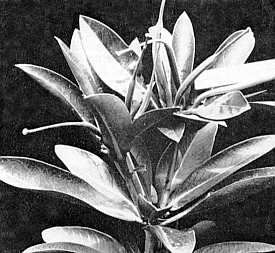Our Front Cover
Rhododendron leucogigas Sleumer
P. H. Brydon

|
|
Fig. 79. Seed pods of
R. leucogigas
6" long. P. H. Brydon photo |
In July. 1961, the Strybing Arboretum in San Francisco's Golden Gate Park received an un-rooted cutting from Dr. H. Sleumer of the Rijksherbarium, Leyden, Netherlands, who was collecting in New Guinea. In his notes accompanying the cutting he stated "Giant rhododendron, aff.
R. tovernae
, Mr. Cyclops, New Guinea, 1200-1340 m. Coll. June 24, 1961. Fls. white. seen in bud only, probably still larger than
R. tovernae
." Dr. Sleumer subsequently described this new species and named it
R. leucogigas
.
From the time the cutting was taken in New Guinea and its arrival in San Francisco, almost three weeks had elapsed. The 100% strike after such a long journey was due to the skillful attention of Mr. John Spring, then Chief Nurseryman in Golden Gate Park. The plant grew vigorously and flowered in January 1968 - a first in the U.S.A. for the Strybing Arboretum.
In the 1967 Rhododendron Yearbook of the Royal Horticultural Society,
R. leucogigas
is described as follows: "Epiphytic lanky shrub up to 2 m, leaves in pseudo-whorls at upper nodes, oblong or sub-elliptic, coriaceous, large, 20-28 (-36) cm. long by 6-10.5 cm. wide. Flowers 6-8 per truss, white suffused with pale carmine at angles of lobes with tube, tubular-funnel form, 7 lobed, up to 14 cm. long, strongly scented. W. N. Guinea; Cyclopp Mts., 1,200 - 1,350 m." This description agrees almost to the cm with my notes from Strybing Arboretum although in our plant, the leaves had not attained the dimensions of those quoted, which is understandable in a young plant.
I recall the floral buds, approximately 1¼ in. in diameter, were covered with protective bracts which were deep maroon, almost black. The cover illustration is almost half life size since the truss was eleven inches in diameter. Dr. Sleumer in his "An Account of Rhododendron in Malesia" describes the fragrance as "strongly carnation scented." This is close and certainly it was almost overpowering in the greenhouse first thing in the morning.
I was intrigued by the development of the seed pod. While it was still green, but almost fully developed as far as size was concerned, an outer skin or stratum dehisced from the bottom of the ovary and recurved towards the style. After this tissue fell away, the ovary dehisced in the usual manner from the top of the capsule. Seed was produced in great abundance and samples went to rhododendron growers in Australia, New Zealand, the British Isles and the U.S.A. Pollen samples were also sent out and reports from hybridists indicate some success on other Malesian species and hybrids. Mention must be made of the cultural skill of Mr. Peter Sullivan who was responsible for bringing this extraordinary species into flower at the Strybing Arboretum.